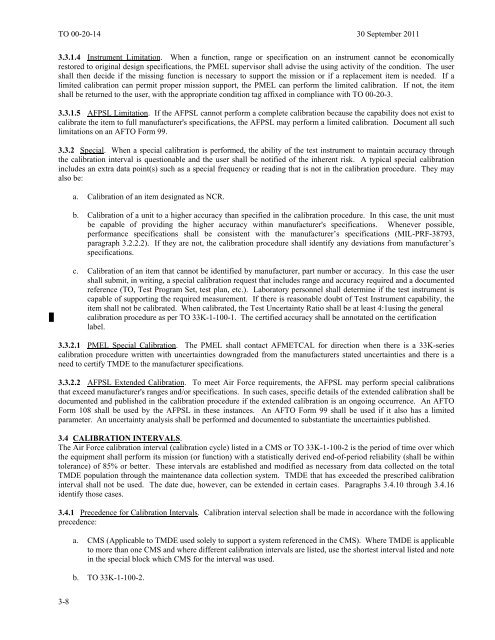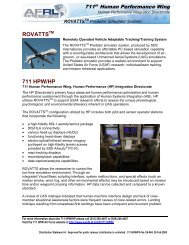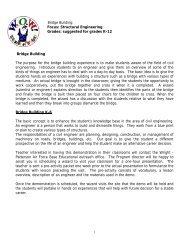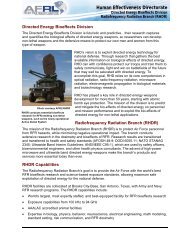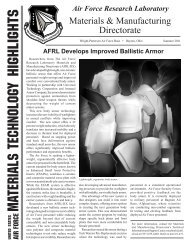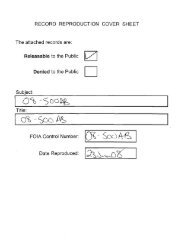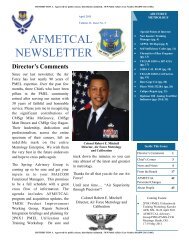TO 00-20-14 30 SEPTEMBER 2011 - Wright-Patterson Air Force Base
TO 00-20-14 30 SEPTEMBER 2011 - Wright-Patterson Air Force Base
TO 00-20-14 30 SEPTEMBER 2011 - Wright-Patterson Air Force Base
- No tags were found...
You also want an ePaper? Increase the reach of your titles
YUMPU automatically turns print PDFs into web optimized ePapers that Google loves.
<strong>TO</strong> <strong>00</strong>-<strong>20</strong>-<strong>14</strong> <strong>30</strong> September <strong>20</strong>113.3.1.4 Instrument Limitation. When a function, range or specification on an instrument cannot be economicallyrestored to original design specifications, the PMEL supervisor shall advise the using activity of the condition. The usershall then decide if the missing function is necessary to support the mission or if a replacement item is needed. If alimited calibration can permit proper mission support, the PMEL can perform the limited calibration. If not, the itemshall be returned to the user, with the appropriate condition tag affixed in compliance with <strong>TO</strong> <strong>00</strong>-<strong>20</strong>-3.3.3.1.5 AFPSL Limitation. If the AFPSL cannot perform a complete calibration because the capability does not exist tocalibrate the item to full manufacturer's specifications, the AFPSL may perform a limited calibration. Document all suchlimitations on an AF<strong>TO</strong> Form 99.3.3.2 Special. When a special calibration is performed, the ability of the test instrument to maintain accuracy throughthe calibration interval is questionable and the user shall be notified of the inherent risk. A typical special calibrationincludes an extra data point(s) such as a special frequency or reading that is not in the calibration procedure. They mayalso be:a. Calibration of an item designated as NCR.b. Calibration of a unit to a higher accuracy than specified in the calibration procedure. In this case, the unit mustbe capable of providing the higher accuracy within manufacturer's specifications. Whenever possible,performance specifications shall be consistent with the manufacturer’s specifications (MIL-PRF-38793,paragraph 3.2.2.2). If they are not, the calibration procedure shall identify any deviations from manufacturer’sspecifications.c. Calibration of an item that cannot be identified by manufacturer, part number or accuracy. In this case the usershall submit, in writing, a special calibration request that includes range and accuracy required and a documentedreference (<strong>TO</strong>, Test Program Set, test plan, etc.). Laboratory personnel shall determine if the test instrument iscapable of supporting the required measurement. If there is reasonable doubt of Test Instrument capability, theitem shall not be calibrated. When calibrated, the Test Uncertainty Ratio shall be at least 4:1using the generalcalibration procedure as per <strong>TO</strong> 33K-1-1<strong>00</strong>-1. The certified accuracy shall be annotated on the certificationlabel.3.3.2.1 PMEL Special Calibration. The PMEL shall contact AFMETCAL for direction when there is a 33K-seriescalibration procedure written with uncertainties downgraded from the manufacturers stated uncertainties and there is aneed to certify TMDE to the manufacturer specifications.3.3.2.2 AFPSL Extended Calibration. To meet <strong>Air</strong> <strong>Force</strong> requirements, the AFPSL may perform special calibrationsthat exceed manufacturer's ranges and/or specifications. In such cases, specific details of the extended calibration shall bedocumented and published in the calibration procedure if the extended calibration is an ongoing occurrence. An AF<strong>TO</strong>Form 108 shall be used by the AFPSL in these instances. An AF<strong>TO</strong> Form 99 shall be used if it also has a limitedparameter. An uncertainty analysis shall be performed and documented to substantiate the uncertainties published.3.4 CALIBRATION INTERVALS.The <strong>Air</strong> <strong>Force</strong> calibration interval (calibration cycle) listed in a CMS or <strong>TO</strong> 33K-1-1<strong>00</strong>-2 is the period of time over whichthe equipment shall perform its mission (or function) with a statistically derived end-of-period reliability (shall be withintolerance) of 85% or better. These intervals are established and modified as necessary from data collected on the totalTMDE population through the maintenance data collection system. TMDE that has exceeded the prescribed calibrationinterval shall not be used. The date due, however, can be extended in certain cases. Paragraphs 3.4.10 through 3.4.16identify those cases.3.4.1 Precedence for Calibration Intervals. Calibration interval selection shall be made in accordance with the followingprecedence:a. CMS (Applicable to TMDE used solely to support a system referenced in the CMS). Where TMDE is applicableto more than one CMS and where different calibration intervals are listed, use the shortest interval listed and notein the special block which CMS for the interval was used.b. <strong>TO</strong> 33K-1-1<strong>00</strong>-2.3-8


